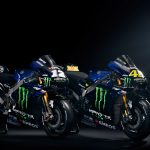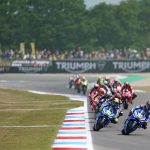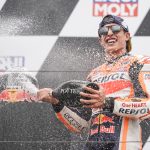The end of the year is traditionally a time to look back and review the season that has just passed. Though I am no great lover of tradition, my last column of 2016 seems like a good place to go over some of the things which I didn’t expect this year. So here are my ‘surprises’ of the year…
The maturity of Marc Márquez
Rostrum or hospital: that was Marc Marquez’ modus operandi for his first three seasons in MotoGP (and come to think of it, his years in 125s and Moto2 as well). But after winning his first two championships in a row, he fell short in 2015, by trying to override an unwilling bike and crashing in the process. The lesson Marquez learned was that he hated losing championships even more than he hated losing races (riders do not race because they love winning, but because they hate losing). In 2016, he put this lesson into practice: instead of crashing trying to win, he stayed on and finished. He even accepted finishing fourth and fifth (the horror! The horror!). Few thought Marquez could tame his impetuous nature. He proved us wrong.
Jorge Lorenzo and the Michelins
When Jorge Lorenzo imposed his will on the MotoGP field at Qatar, it looked like the Movistar Yamaha rider was on a path to repeat his championship-winning performance from the previous year. Putting that win together with his dominance at the Sepang test had everyone braced for a runaway year for Lorenzo. Then in Argentina, Scott Redding’s rear tyre exploded, and Michelin swung their tyre design in a much harder direction. Lorenzo no longer had the edge grip he needed to carry his trademark corner speed. The Michelin wet tyres were even worse for him: the tread moved so much he could not feel the limit, and it took him several races to get his head around them. Luckily (and unluckily) for Lorenzo, it rained a lot, so he got plenty of practice, but that also meant he had a lot of mediocre results. On his day, Jorge Lorenzo is the fastest motorcycle racer in the world. But his failure to manage the Michelins saw him come up very short in the title chase.
The Pramac Ducati GP15s finishing behind Ducati GP14.2s
Pramac Ducati is still very much the junior Ducati factory team. Pramac is run with a lot of support from the Bologna factory, and given the next best equipment. Ducati has a major say in rider signings, the idea being that the team is a place to put talent with potential to move up to the factory team in the future. So it has been a major disappointment that both Scott Redding and Danilo Petrucci finished behind the two-year-old Ducati GP14.2 machines of Hector Barbera and Eugene Laverty. Not just in the championship: on ten out of the eighteen races, Barbera or Laverty finished ahead of at least one Pramac rider. There were plenty of reasons for this: Petrucci was carrying a hand injury early in the season, and missed several races. Redding had a surprising amount of mechanical misfortune through the year. But the fact was that two riders regarded as young talents were regularly beaten by old men on old bikes. Both Laverty and Barbera are extremely underrated riders, but that simply shouldn’t happen.
Franco Morbidelli
The Moto2 championship in 2016 looked a little too much like 2015. Same faces, same names, and in the end, the same champion as last year. The exception was Franco Morbidelli, the Italian who had switched from the mid-pack Italtrans team to former champions Marc VDS Racing. Morbidelli made the step forward that was expected of him going to a more competitive team, ending the year with eight podiums and finishing just a single point shy of Alex Rins, the man the media have anointed a future superstar. Though Morbidelli did not win a race, he all too often put the established stars such as Rins, Tom Luthi, Johann Zarco and Sam Lowes to shame. The chirpy Italian starts 2017 as title favourite. The tables have now been turned.
The irresistible rise of Brad Binder
What a difference a win makes. Brad Binder was a rider who was there or thereabouts, but always seemed to lack that final edge, the difference between winning and losing. He started the season in the running for the Moto3 title, but nobody expected him to run away with it. That all changed after his astounding win at Jerez. He found out he had to start from the back of the grid just after morning warm up, over a trivial infraction (a misnamed ECU software map). He sliced through the field like a hot knife through butter, got to the front, realised he was faster than everyone else, and cleared off. From that moment on, he was the man to beat, almost always in the top three or four every lap, winning eight races, only missing out on the podium in three. Binder clinched the title at Aragon, with four races to go. He rode a near-perfect season, something not expected of a Moto3 rider. “He is a warrior, he will sacrifice anything to win” team boss Aki Ajo told me. Watch out for how he progresses in Moto2.
Fabio Di Giannantonio – the non-VR46 Italian
It is impossible to overstate just how important Valentino Rossi’s VR46 Rider Academy has been to the revitalisation of Italian racing. Rossi’s academy has produced a seemingly unending supply of young Italian talent. Fabio Di Giannantonio’s rise has been all the more remarkable for the VR46 operation not having had any part in his success. The Italian – God, how we non-Italian journalists sweated over the jumble of A’s, N’s, and O’s in that name – was the revelation of the Moto3 class, adding consistency to his outright speed. He was meant to be the junior teammate of Enea Bastianini, but Di Giannantonio was so much more. Smart, articulate, with impeccable English and astounding speed, Di Giannantonio is a sign of the rude health of Italian racing.
Romano Fenati – Paradise Lost
Romano Fenati probably peaked too early, and has suffered the consequences ever since. Second in his first ever Grand Prix, a winner in his second, the world was Fenati’s oyster. The problem was, he wasn’t ready for such success at the tender age of 16, and it all went to his head. He was rebellious, difficult to work with, and always seemed to manage to snatch defeat from the jaws of victory. The Sky VR46 team was meant to get him into line, and focus his mind on winning, but that all fell apart at mid-season. After one argument too many, and a refusal to abide by the rules of the team, Fenati was sacked, and sent home. It was a miserable temporary end to a promising career, and a salutary lesson on the value of self-discipline. We will see if he has really learned his lesson in 2017.








